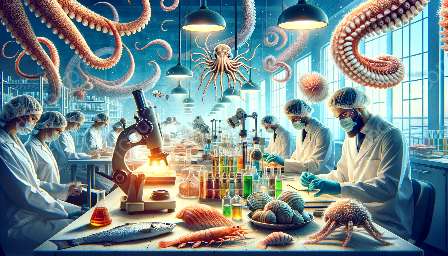Seafood quality control and assessment are essential aspects of seafood science, encompassing various factors such as physical attributes. In this comprehensive guide, we will explore the significance of physical attributes in ensuring the quality of seafood products, the methods used to assess and control these attributes, and their impact on the overall consumer experience.
Understanding Physical Attributes in Seafood Quality Control
Physical attributes in seafood refer to the visual, tactile, and structural properties of seafood products that can be evaluated and quantified to determine their quality. These attributes play a crucial role in assessing the freshness, shelf life, and overall appeal of seafood, influencing consumer perceptions and purchase decisions.
Importance of Physical Attributes
The physical appearance of seafood, including color, texture, and odor, serves as an immediate indicator of its quality and safety. Consumers often rely on these attributes to make informed choices when purchasing seafood products. Therefore, it is vital for seafood industry professionals to understand and control these physical attributes to maintain high-quality standards.
Factors Affecting Physical Attributes
Several factors can impact the physical attributes of seafood, including species, handling practices, storage conditions, and processing methods. Understanding these influences is necessary for effective quality control and assessment, as they help identify potential issues that could compromise the integrity of seafood products.
- Species: Different species of seafood exhibit distinct physical attributes, such as color, texture, and fat content. Understanding these variations is crucial for accurately assessing the quality of each type of seafood.
- Handling Practices: Proper handling during harvesting, transportation, and storage is essential for preserving the physical attributes of seafood. Factors such as temperature control, packaging, and hygiene practices directly impact the quality and appearance of seafood.
- Storage Conditions: Temperature, humidity, and exposure to light can profoundly influence the physical attributes of seafood. Proper storage conditions are critical for maintaining freshness and minimizing deterioration.
- Processing Methods: Various processing techniques, such as freezing, filleting, and packaging, can impact the texture, color, and overall appearance of seafood products. Understanding the effects of different processing methods is vital for ensuring consistent quality.
Assessment and Control Methods
Seafood quality control involves the use of specific methods and tools to assess and control physical attributes. These methods aim to maintain the desired quality standards and ensure that the seafood meets regulatory requirements and consumer expectations.
Visual Inspection
Visual assessment is one of the primary methods for evaluating the physical attributes of seafood. It involves inspecting the color, clarity, texture, and overall appearance of the product to identify any abnormalities or signs of spoilage. This method provides valuable insights into the freshness and quality of seafood.
Texture Analysis
Texture analysis, using instruments such as texture analyzers, measures the firmness, elasticity, and other textural properties of seafood. This method is useful for assessing the tenderness, juiciness, and overall mouthfeel of seafood products, which are important factors for consumer satisfaction.
Olfactory Examination
The sense of smell plays a significant role in assessing the freshness and safety of seafood. Olfactory examination involves detecting any off-putting odors or signs of decomposition, providing critical information about the product's condition.
Instrumental Analysis
Instrumental methods, such as spectrophotometry and gas chromatography, are utilized to quantitatively measure physical attributes such as color, fat content, and chemical composition. These precise measurements help verify the quality and nutritional properties of seafood products.
Impact on Consumer Experience
The physical attributes of seafood directly influence the consumer experience, shaping their perceptions of quality, freshness, and value. By controlling and maintaining these attributes, seafood producers and retailers can enhance consumer satisfaction and build trust in their products.
Consumer Perception
Consumers form initial impressions of seafood based on its visual appearance, texture, and aroma. Products with desirable physical attributes are perceived as fresh, high-quality, and nutritious, appealing to a broader audience.
Purchase Decisions
Quality physical attributes positively influence consumer purchase decisions, leading to repeat purchases and brand loyalty. Seafood products that consistently demonstrate superior physical qualities are more likely to gain a competitive edge in the market.
Overall Satisfaction
When seafood products exhibit excellent physical attributes, consumers experience higher satisfaction, resulting in positive reviews and recommendations. This fosters a positive brand image and contributes to the long-term success of seafood businesses.
Conclusion
Physical attributes are integral components of seafood quality control and assessment, playing a significant role in determining the overall quality and consumer appeal of seafood products. By understanding the importance of these attributes, implementing effective assessment and control methods, and prioritizing consumer satisfaction, the seafood industry can uphold high standards and deliver exceptional products to the market.

